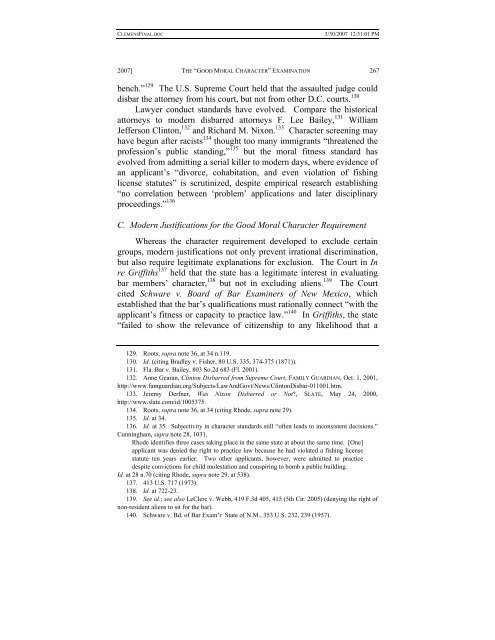Facing the Klieg Lights: Understanding the "Good Moral Character"
Facing the Klieg Lights: Understanding the "Good Moral Character"
Facing the Klieg Lights: Understanding the "Good Moral Character"
Create successful ePaper yourself
Turn your PDF publications into a flip-book with our unique Google optimized e-Paper software.
CLEMENSFINAL.DOC<br />
3/30/2007 12:51:01 PM<br />
2007] THE “GOOD MORAL CHARACTER” EXAMINATION 267<br />
bench.” 129 The U.S. Supreme Court held that <strong>the</strong> assaulted judge could<br />
disbar <strong>the</strong> attorney from his court, but not from o<strong>the</strong>r D.C. courts. 130<br />
Lawyer conduct standards have evolved. Compare <strong>the</strong> historical<br />
attorneys to modern disbarred attorneys F. Lee Bailey, 131 William<br />
Jefferson Clinton, 132 and Richard M. Nixon. 133 Character screening may<br />
have begun after racists 134 thought too many immigrants “threatened <strong>the</strong><br />
profession’s public standing,” 135 but <strong>the</strong> moral fitness standard has<br />
evolved from admitting a serial killer to modern days, where evidence of<br />
an applicant’s “divorce, cohabitation, and even violation of fishing<br />
license statutes” is scrutinized, despite empirical research establishing<br />
“no correlation between ‘problem’ applications and later disciplinary<br />
proceedings.” 136<br />
C. Modern Justifications for <strong>the</strong> <strong>Good</strong> <strong>Moral</strong> Character Requirement<br />
Whereas <strong>the</strong> character requirement developed to exclude certain<br />
groups, modern justifications not only prevent irrational discrimination,<br />
but also require legitimate explanations for exclusion. The Court in In<br />
re Griffiths 137 held that <strong>the</strong> state has a legitimate interest in evaluating<br />
bar members’ character, 138 but not in excluding aliens. 139 The Court<br />
cited Schware v. Board of Bar Examiners of New Mexico, which<br />
established that <strong>the</strong> bar’s qualifications must rationally connect “with <strong>the</strong><br />
applicant’s fitness or capacity to practice law.” 140 In Griffiths, <strong>the</strong> state<br />
“failed to show <strong>the</strong> relevance of citizenship to any likelihood that a<br />
129. Roots, supra note 36, at 34 n.119.<br />
130. Id. (citing Bradley v. Fisher, 80 U.S. 335, 374-375 (1871)).<br />
131. Fla. Bar v. Bailey, 803 So.2d 683 (Fl. 2001).<br />
132. Anne Gearan, Clinton Disbarred from Supreme Court, FAMILY GUARDIAN, Oct. 1, 2001,<br />
http://www.famguardian.org/Subjects/LawAndGovt/News/ClintonDisbar-011001.htm.<br />
133. Jeremy Derfner, Was Nixon Disbarred or Not?, SLATE, May 24, 2000,<br />
http://www.slate.com/id/1005375.<br />
134. Roots, supra note 36, at 34 (citing Rhode, supra note 29).<br />
135. Id. at 34.<br />
136. Id. at 35. Subjectivity in character standards still “often leads to inconsistent decisions.”<br />
Cunningham, supra note 28, 1031.<br />
Rhode identifies three cases taking place in <strong>the</strong> same state at about <strong>the</strong> same time. [One]<br />
applicant was denied <strong>the</strong> right to practice law because he had violated a fishing license<br />
statute ten years earlier. Two o<strong>the</strong>r applicants, however, were admitted to practice<br />
despite convictions for child molestation and conspiring to bomb a public building.<br />
Id. at 28 n.70 (citing Rhode, supra note 29, at 538).<br />
137. 413 U.S. 717 (1973).<br />
138. Id. at 722-23.<br />
139. See id.; see also LeClerc v. Webb, 419 F.3d 405, 415 (5th Cir. 2005) (denying <strong>the</strong> right of<br />
non-resident aliens to sit for <strong>the</strong> bar).<br />
140. Schware v. Bd. of Bar Exam’r State of N.M., 353 U.S. 232, 239 (1957).
















